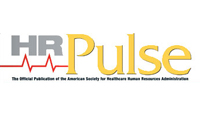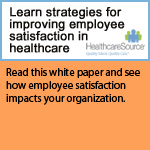| September 16, 2010 | Printer Friendly Version | Advertise | Join ASHHRA | ||

|
PRESIDENT'S MESSAGE
Dear ASHHRA Members, Finally... the goal is in sight. The actual event is on the horizon. The fun is about to begin.
It's all coming together! On September 25th, the 46th Annual ASHHRA Conference and Exposition kicks off in beautiful Tampa, Florida. We hope to see you there! If you haven't registered, it's not too late! If you have, fantastic! This will simply be THE premier health care HR event of the year... and you won't want to miss it. Jeff Payne, SPHR ASHHRA NEWS
LEGAL
WORKFORCE
COMPENSATION
GENERAL HR
BENEFITS
PHYSICIANS
MANAGEMENT & LEADERSHIP
ASHHRA NEWS
LEGAL
The federal government wants to put an end to misclassification of workers as independent contractors and has the health care industry in its sights. Earlier this year, the United States Department of Labor (DOL) and the Treasury Department announced an interagency "Misclassification Initiative." The Initiative involves millions of dollars, new personnel, targeted audits, and even training of OSHA investigators to spot misclassification problems and "rewards" for states that are the most successful in finding and correcting misclassification. The DOL is planning on an additional 4,700 investigations targeting problem industries. Home health care is specifically listed as one of those "problem industries." All employers in the health care industry should be on guard. Treating workers as independent contractors has been a long standing practice in many facets of the health care industry, and with good reason. Many workers in the industry enjoy the freedom and flexibility of independent contractor status. Companies like it because they do not have to provide employee benefits to true independent contractors, do not have to pay them overtime or minimum wage, and do not have to include them for purposes of other laws, including the recent federal health care reform legislation. If, however, a company misclassifies an employee as an independent contractor, the company is violating a plethora of employment statutes and also is depriving the government of tax dollars. In light of the growing deficit, those lost tax dollars present a huge issue for both state and federal governments – an issue that they are not taking lightly. In addition to the misclassification Initiative, legislation is pending in Congress that would change tax and wage and hour laws regarding independent contractors and impose new requirements on companies. The proposed Employee Misclassification Prevention Act (EMPA), for example, will require employers to notify workers of their status and right to go to the DOL, and presumes that workers are employees if the notice is not given. Even if EMPA does not become law, the DOL has given notice of proposed regulations that would impose similar requirements. States are jumping in on the act as well with their own legislation and task forces. Are you getting the impression that the government would prefer that your workers be employees? Don’t panic yet. There are steps that you can take now to minimize your company’s risk before the government comes knocking. The first step is to determine whether any of your independent contractors are actually employees. Look at the workers who get 1099s from your company. The tests applied by courts and governmental agencies vary depending on the law and the state. (See the chart for a summary of the factors applied under three important federal laws.) There are, however, some common themes. The number-one factor is the degree of control that the employer exercises. The more control exerted by the employer, the more likely it is that the person is an employee. If you or your supervisors are telling your workers when, where and how to do the work and requiring them to follow set rules and sequences, those workers are probably employees. Other important factors include the worker’s opportunity for profit or loss by managing the manner in which he or she works. Generally, work that is time oriented, rather than project oriented, will indicate employee status, while the ability of a worker to earn more money by working more efficiently is a factor indicating independent contractor status. The worker’s investment in equipment, materials, insurance or workers that is significantly greater than the employer’s investment in such items indicates independent contractor status. No single factor is controlling. Factors that are not relevant, however, include a contract describing the worker as an independent contractor and even the worker’s own request to be treated as an independent contractor. In short, if it walks like an employee and quacks like an employee, it probably is. If your audit indicates that your workers are close to the line, consider whether your company can make changes in the way the workers are treated to increase the factors that make a worker an independent contractor. For example, can your company give the worker discretion over where and how to work, allow the worker to work for other employers, and change the compensation arrangement so that the worker has more opportunity to make more money by working harder or more efficiently? When you’re hiring independent contractors, consider having workers complete a questionnaire verifying their independent contractor status. Also take a look at the terms of your contractor agreement. Remove provisions that set forth specific duties and requirements and instead give the worker discretion over the manner and means of performing services for your company. Require the worker to have his or her own business, federal employer identification number and insurance. Require the worker to provide his or her own truck, tools, equipment and helpers. Make clear in the contract that the worker is responsible for the taxes, workers’ compensation coverage and benefits for himself and his employees. Remove any at-will termination provisions and instead provide for termination only on breach of the agreement, bankruptcy, insolvency or death of a party, the completion of the services, or when both you and the worker agree. In addition, remember to keep records demonstrating that the worker is an independent contractor. These records include the worker’s 1099s, federal employer number, business licenses, certificates of insurance (including workers’ compensation insurance), public advertisements for his business, business cards, and invoices that the worker uses to bill your company. If, however, your workers are so far over the employee line that they cannot be brought back to independent contractor status (or you don’t want to bring them back), the best approach is to officially alter their status to that of an employee and fix their tax treatment, workers’ compensation coverage and benefits. Seek the advice of legal counsel. There are a number of pitfalls, particularly with employee benefit plans, if the process is not handled correctly. Karin McGinnis is a litigator and employment and labor lawyer at Moore & Van Allen (www.mvalaw.com), handling a broad range of workplace-related matters. McGinnis has successfully litigated a wide variety of employment issues on behalf of employers in federal and state court as well as in arbitration. She can be reached at (704) 331-1078 or karinmcginnis@mvalaw.com. While tough economic times continue, companies everywhere are creating innovative solutions to keep their loyal staff happy. As the company pocketbooks don’t have the spare cash for generous raises, many employers are turning to title promotions with slight raises as a way to show their appreciation. And while there’s nothing wrong with advancing a competent person, employment law experts warn companies to maintain integrity when giving promotions and be aware of potential legal risks associated with job title inflation. "If you’re inflating job titles, you’re breaking down traditional boundaries in the duties category. While employers may have good intentions, if you start inflating titles, the titles themselves don’t reflect the duties of the position and required expertise. It also can become confusing, disorganizing and difficult when striving to maintain job classifications and proper salaries when the economy bounces back – including dealing with inaccurate job descriptions with misleading duties requirements, which can converge to cause difficulty separating exempt and non-exempt employees," said John K. Skousen, Partner, Fisher & Phillips LLP. John K. Skousen, partner at the Irvine, Calif. office of employment law firm Fisher & Phillips LLP and an expert on performance management issues, has extensive experience representing a wide variety of regional and national companies with respect to all aspects of employment litigation. His specialized practice area includes wage and hour law and class-action litigation, making him the ideal representative to lend insight on what employers need to know in regard to latest trends in job title inflation and the potential negative consequences facing companies that engage in this practice. Skousen offers the following issues to consider before implementing title changes in today’s economy:
Labor and employment law firm Fisher & Phillips LLP represents a wide variety of national and regional employers. The firm’s Irvine, Calif. office – one of 23 nationwide – offers a wide range of services to private and public sector clients, both unionized and non-unionized. With a focus on both preventive counseling and defense of claims, the firm addresses the business and legal objectives of employers in a way that optimizes their clients’ performance in today’s changing marketplace. To learn more about Fisher & Phillips, visit www.laborlawyers.com. COMPENSATION
GENERAL HR
BENEFITS
Catalyst Learning Co. (CLC) has begun its graduation ceremonies for more than 140 working adult students at 13 hospitals in Chicago for the School at Work (SAW) "Building a Career Ladder in Healthcare" Program. This is a national record for one city and is an example of a workforce development program in action, servicing participants and health care needs. The SAW project was strongly supported with funding from Central States Service Employment Redevelopment (SER) and the Chicago Department of Community Development (DCD). The project provided front-line, incumbent health care workers with the education, skills and confidence to advance in their careers, opening up other academic opportunities for these workers to enter nursing and other fields. An example of rapid success for participants in SAW can be found at Saint Anthony’s Hospital on Chicago’s Southwest side. Their first 2008 graduates moved up into higher-paying health care careers where there have been shortages, and, by setting an example of achieve from possibility, the Metropolitan Chicago Health Care Council recommended that DCD fund a citywide expansion of SAW up to 150 employees. Participating hospitals in the SAW project are: Advocate South Suburban, Children’s Memorial Medical Center, Sinai Health System, Norwegian-American Hospital, Our Lady of Resurrection, Resurrection Medical Center, Roseland Community Hospital, South Shore Hospital, Saint Anthony Hospital, St. James Hospital and Health Centers, Swedish Covenant Hospital, and University of Chicago Medical Center. The students generally achieve high levels of self-esteem and are motivated to take action to train and seek higher education to achieve higher-paying health care positions at their hospitals, explained David Hanson, executive director of DCD’s Business Development Services unit. This, in turn, opens doors to possibilities within their lives and their neighborhoods, he added. The SAW program has been highly successful nationwide, and stories of graduates are inspirational. Elizabeth Snow King participated in School at Work at Williamson Medical Center, and was recently promoted from housekeeping to unit secretary in the hospital’s critical care unit. She said, "I saw an improvement in myself that I didn’t think possible." Jazette L. Moffitt is a 2009 graduate of SAW at Saint Anthony Hospital. This Medical Claims Analyst credited the experience with improving her quality of life. "It caused me to think on a larger scale about what I want to do for my children, my employer, and helped me know that I can achieve a goal if I plan and prepare." These adults have been able to learn skills that set them up to achieve their goals and serve their communities in ways they only imagined. "This Chicago project affects the most residents in an urban area in SAW’s history. SAW will continue to graduate its recent participants in the Chicago region through October this year and it has maintained workforce development opportunities that continue expand in the area’s hospitals due to growth and retention," said Lynn Fischer, CLC CEO and founder. "I commend SAW leaders in all our hospitals and the students for their dedication to excellence in health care. Together, we are making Chicagoland a better place to live, work, and raise families," according to Mayor Richard M. Daley’s recent letter to Michael Englehart, CEO of Advocate South Suburban Hospital, and all the participating CEOs. Advocate South Suburban Hospital completed its graduation ceremony in August. The average graduate will see an increase in income to their bottom-line salary from participation in this program, contributing to the city’s overall economic development as well quality health care services. On average, approximately 17 percent of the project participants will receive a job advancement within 90 days of graduation, according to company numbers. From the same data, an additional 33 percent will eventually enroll in continuing education. Completed and Upcoming Graduation Dates Announced: Catalyst Learning Company, a health care workforce development company based in Louisville, KY, is the provider of School at Work, Expanding your Career and Health care Opportunities and CareerCare. SAW and ECHO are career development systems for entry and mid-level employees. The programs use a blended learning model, involving the Internet and DVD technology, peer discussion, and personal coaching. CareerCare is a web-based career planning tool designed exclusively for the health care industry. These products support Catalyst Learning’s vision to dramatically increase the number of hard-working adults who are able to achieve the American dream. Learn more by visiting www.catalystlearning.com. "I just want whatever I had last year." If you’re in charge of benefits selection at a company, you’ve probably heard that before. According to Hewitt Associates, in 2010, 55 percent of employees passively defaulted to the same health insurance coverage they had the previous year. But with health costs rising and family needs changing every year, it’s often surprising that employees don’t at least look at other options to see if they’ve selected the right plan for them. Why should you care, you might ask? Because SHRM reports that benefits are the number two deciding factor in employee satisfaction and retention. It’s important to educate employees about their benefits and help them choose the option that meets their needs. Let’s consider this "whatever I had last year" mindset, and identify ways to help your employees actually find a plan that’s right for them THIS year. The Status Quo Effect Psychologists Daniel Goldstein and Eric Johnson found that countries that are culturally and economically very similar actually have wildly dissimilar participation in organ donation programs. For instance, Denmark has a 4 percent organ donation rate while Sweden has an 86 percent rate. Why the difference? When people in Denmark go to DMV, they see a form with a question reading "Check the box below if you WANT to participate in the organ donor program." In Sweden, people at the DMV read this: "Check the box below if you DON’T WANT to participate in the organ donor program." Why are people swayed so much by the structure of the form? It’s because the decision can be a difficult one to make. They know it’s important, but they don’t know what to decide. So, they don’t decide anything and go with the default choice. This is called the status quo effect. The same thing happens with insurance plans. People don’t know what to decide so they don’t decide anything and just go with what they had last year. So, if you would like your employees to not just go with the status quo, you need to make the decision-making process easier:
Loss Aversion Let’s review an experiment by psychologists Daniel Kahneman, Jack Knetsch and Richard Thaler. A group of people were split in half. One half of the individuals were given coffee mugs. Each person was then paired off with someone from the other group and given a sheet of paper listing a bunch of possible prices for the mug. Those with the mug secretly marked off the price they’d be willing to sell the mug for and those without the mug secretly marked off the price they’d be willing buy the mug for. The result? People who already had the mug consistently valued it at twice the amount of people without the mug. This is called loss aversion. Losing something gives people twice the amount of negative feelings as gaining the same thing gives them positive feelings. People have the same reaction with health insurance plans – they double their perceived value of the plan they have. If you want them to be happy with a new plan, you have to:
Miller’s Law The reason is that there are too many factors to keep in mind when choosing an insurance plan. How much medical care do you think you’ll need? What about your family? What size deductible should you choose? How about the premium? How many medications do you need covered, etc. We could go on and on – the average human brain can’t process all of it all at once. That’s actually true. Psychologist George Miller conducted a series of studies that found that humans can only handle five to nine pieces of information in our working memory at any given time. This is called Miller’s Law. Now look at that list again of the variables you need think about when you’re picking out a health insurance plan. Even if you only have two plans to choose from, there are still too many factors to consider at once when making the decision. So...
Times are Changing
Using an interactive health insurance plan recommender, you can address all three of these issues and fundamentally change the way your employees choose new plans. And here’s the best news. When employees stop asking "why can’t I just have whatever plan I had last year," they end up finding the plan that’s right for them. It saves them money and it saves your company money. And that’s a good investment for everyone. Dave Urlakis is the Director of Analytics for The Jellyvision Lab, where he and his team evaluate and optimize the performance of Interactive Conversations for a bevy of Fortune 1000 clients. Before arriving at The Jellyvision Lab, Dave worked at the world-renowned Steppenwolf Theatre Company where he was an industry leader and advocate for leveraging predictive analysis and digital media for theatrical productions, presented at the National Performing Arts Convention and Theatre Communications Group National Conference and awkwardly rode elevators with John Malkovich. Jellyvision is probably best known for its award-winning video game franchise You Don’t Know Jack. So, why did a company known for making virtual game show hosts write an eBook about helping employees navigate changes to their health insurance plan? Well, The Jellyvision Lab has taken what we’ve learned about making virtual game show hosts and used it to help our roster of awesome clients create virtual teachers, insurance agents, salespeople, you name it. We’ve created award-winning, interactive rich media solutions that have increased customer satisfaction scores, generated higher quality sales leads and actually gotten employees to enjoy the process of selecting their health insurance plan. We get results. We also get curly fries whenever they’re available at a restaurant. But that’s enough talk – if you really want to see what we do, check out the examples page on our website and then give us a call. PHYSICIANS
MANAGEMENT & LEADERSHIP
|
ASHHRA Mission To advance the human side of health care, the American Society for Healthcare Human Resources Administration (ASHHRA) leads the way for highly effective, valued, and credible leaders. Contact: ASHHRA FOLLOW US ON |

|

|
 |
155 North Wacker, Suite 400 Chicago, IL 60606 Ph.: 312.422.3720 Fax: 312.422.4577 E-mail: ashhra@aha.org Website: www.ashhra.org |










